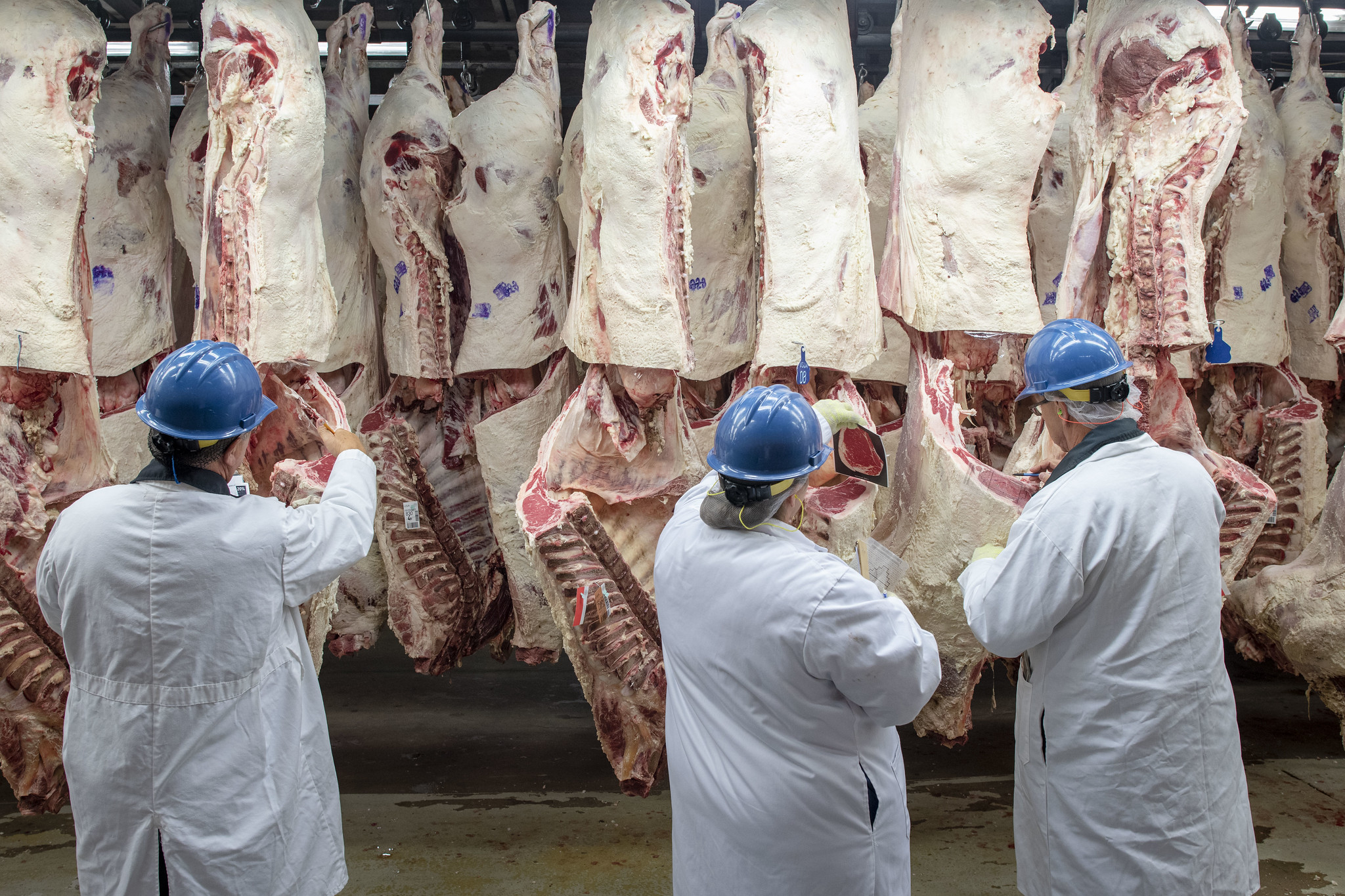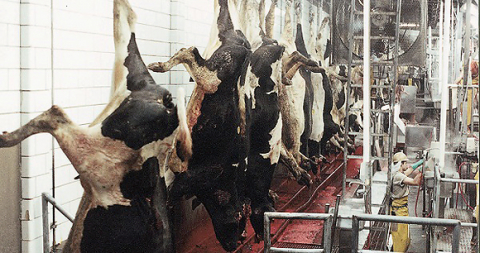Slaughterhouses In The Us
In 1869 the Louisiana state legislature granted a monopoly of the New Orleans slaughtering. We have slaughterhouses that will process 300 400 cattle an hour which is as much as twice.
 Meat Shortages Reopen Costly Path To Small Us Slaughterhouses Transport Topics
Meat Shortages Reopen Costly Path To Small Us Slaughterhouses Transport Topics
It reached a record new high in the year 2000 and according to a survey it will keep on rising in the near future as well.

Slaughterhouses in the us. A new report by the Government Accountability Office reveals that many injuries and illnesses sustained by meat and poultry workers go unreported. There are more than 800 federally inspected slaughterhouses in the United States according to recent USDA data. At that time most Americans were not aware that this industry even existed.
Meet their ends in American slaughterhouses pounds open spaces and labs for the production of food for humans. An eye opening look at the most transparent slaughterhouse on earth. ERROR TO THE SUPREME COURT OF LOUISIANA 1.
Considering the psychological and physical trauma of this kind of work the compensation is low and leaves workers less inclined and motivated to treat the animals well. The legislature of Louisiana on the 8th of March 1869 passed an act granting to a corporation created by it the exclusive right for twenty-five years to have and maintain slaughterhouses landings for cattle and yards for. 97 of animals killed in the US.
Slaughterhouses which rank among the most dangerous places to work in the United States have grown safer in recent years. But theres still progress to be made. Slaughtering animals and processing their flesh is an inherently dangerous industry where company profits consistently take priority over workers most basic rights.
Slaughterhouses and meat-processing facilities employ over 500000 workers. Media stories have recently documented the difficulties many small. The slaughterhouses that the United States have are pretty unique in terms of the speed of production.
Today due to a mixture of fragile and now rescinded appropriation cuts state legislation and court rulings there are no horse slaughter plants currently operating in the US. Beltex Corporation in Fort Worth and Cavel International in DeKalb Illinois. Slaughterhouse Cases in American history legal dispute that resulted in a landmark US.
Httpsyoutube7ARrGP_u89gSign up for a 22 day vegan challenge here. According to the Bureau of Labor Statistics half a million people in the US alone work in slaughterhouses. 36 36 1872 Slaughterhouse Cases 83 US.
Velda owned Cavel Multimeat owned Beltex and Chevideco owned Dallas Crown. The average workers make around 12hour and less than 28000 per year before taxes. The table below from USDAs National Agricultural Statistics Service NASS on the number of livestock slaughter plants poultry plants are not included shows how the local slaughterhouse infrastructure has deteriorated in the United States over the past fifty years.
Supreme Court decision in 1873 limiting the protection of the privileges and immunities clause of the Fourteenth Amendment to the US. It was foreign interests that first built equine slaughterhouses in the United States and by the 1990s there were at least sixteen of them operating all across the country. A risky US Department of Agriculture USDA high-speed slaughter program would allow facilities to increase slaughter speeds and shift responsibility of food safety oversight into the hands of.
In 1967 at the time of the passage of the Wholesome Meat Act there were nearly 10000 1 slaughterhouses in the country. After decades of consolidation there are about 800 federally inspected slaughterhouses in the United States processing billions of pounds of meat for food stores each year. Find Part 2 here.
Nearly twenty years ago there were up to 14 active horse slaughter plants in the United States gradually reducing their numbers due to diminishing foreign demand for horse meat in the late 90s. All were Belgian-owned with Multimeat also having French and Dutch ownership. Before 2007 three major equine slaughterhouses operated in the United States.
The production of these products for local and regional markets is of course dependent on the availability of facilities that slaughter and process livestock and poultry. Another 1800 are operated by states or are custom slaughterhouseswhere sales are severely restricted to prohibit for example sales to grocers. While the coronavirus spread through American slaughterhouses last month the USDA introduced a similar program that will enable Tyson and other.
Supreme Court Slaughterhouse Cases 83 US. 1 In their endless goal of higher volume and greater efficiency these corporations. Cross-Posted from the Know Your Farmer Know Your Food Blog Meat and poultry products are important commodities within many local and regional food systems.
Dallas Crown in Kaufman Texas.
 Support Industrial Slaughterhouses Pacific Standard
Support Industrial Slaughterhouses Pacific Standard
 Slaughterhouses The Horrifying Secrets About How Meat Is Made
Slaughterhouses The Horrifying Secrets About How Meat Is Made
 Ranchers Animal Welfare Groups Rethinking Horse Slaughterhouses Wsj
Ranchers Animal Welfare Groups Rethinking Horse Slaughterhouses Wsj
 More Foreign Ownership Of U S Beef Processors Raises Food Safety Concerns Investigate Midwestinvestigate Midwest
More Foreign Ownership Of U S Beef Processors Raises Food Safety Concerns Investigate Midwestinvestigate Midwest
 Slaughterhouses The Horrifying Secrets About How Meat Is Made
Slaughterhouses The Horrifying Secrets About How Meat Is Made
 The Food Chain S Weakest Link Slaughterhouses The New York Times
The Food Chain S Weakest Link Slaughterhouses The New York Times
 Poultry Slaughterhouse Distribution By Size Source Usda Food Safety Download Scientific Diagram
Poultry Slaughterhouse Distribution By Size Source Usda Food Safety Download Scientific Diagram
/https://www.thestar.com/content/dam/thestar/news/insight/2010/05/14/probing_the_link_between_slaughterhouses_and_violent_crime/insaabbatori15jpg.jpeg) Probing The Link Between Slaughterhouses And Violent Crime The Star
Probing The Link Between Slaughterhouses And Violent Crime The Star
 Kit International Usa Visit Brazilian Slaughterhouses To Restart Imports Of Beef
Kit International Usa Visit Brazilian Slaughterhouses To Restart Imports Of Beef
 America S Horrifying New Plan For Animals Highspeed Slaughterhouses Animals The Guardian
America S Horrifying New Plan For Animals Highspeed Slaughterhouses Animals The Guardian
Largest Illegal Us Slaughterhouse Raided Closed Off Track Thoroughbreds
 How Slaughterhouses Became Breeding Grounds For Coronavirus Financial Times
How Slaughterhouses Became Breeding Grounds For Coronavirus Financial Times

Comments
Post a Comment